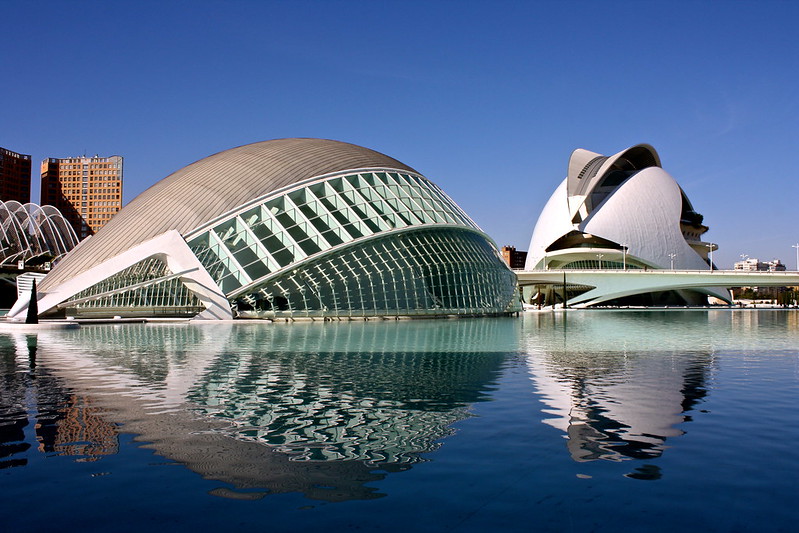Valencia, Spain: A Pretty, Tasty City Worth Visiting
 |
| Flags of Spain & Valencia |
Valencia may be Spain’s third largest city, but it’s hardly its third-most-visited one. Perhaps passed over by tourists on their way from Barcelona to Madrid, Sevilla, or Granada, or skipped in favor of other Mediterranean beach towns, Valencia sadly doesn’t have as much fame as Toledo or San Sebastián might for people traveling around Spain.
I have to admit, I wasn’t even planning on taking a trip here until I ran across Zach Frohlich’s blog Not Hemingway’s Spain, a website where he not only tries to break down stereotypes about Spain but also introduces readers to his adopted hometown of Valencia. His many blog posts about the city convinced me it was worth going to, and besides, I had some friends from college studying abroad in a town two hours south (Alicante), so I thought, what the heck, why not? It ended up being a great decision and I realized Valencia is one of the most beautiful cities in the country.
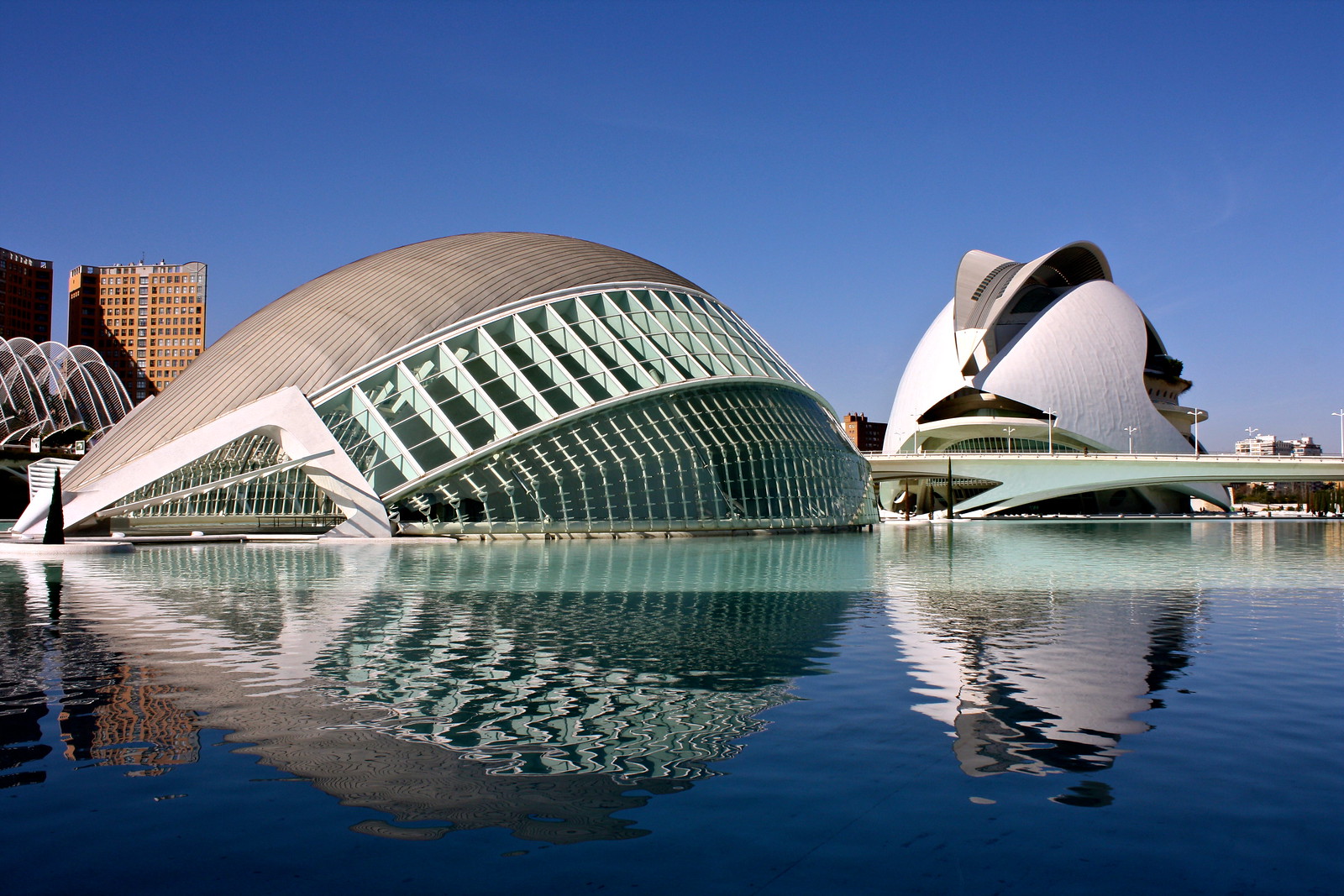 |
| City of Arts and Sciences |
In case you haven’t picked it up from this blog already, I’m a big architecture nerd, and Valencia’s is simply lovely. A series of plazas from the train station to the northern edge of the old town take you back in time from Modernista to Renaissance to Gothic styles, and closer to the beach, you’ll get a taste for the exciting world of contemporary architecture.
The old town
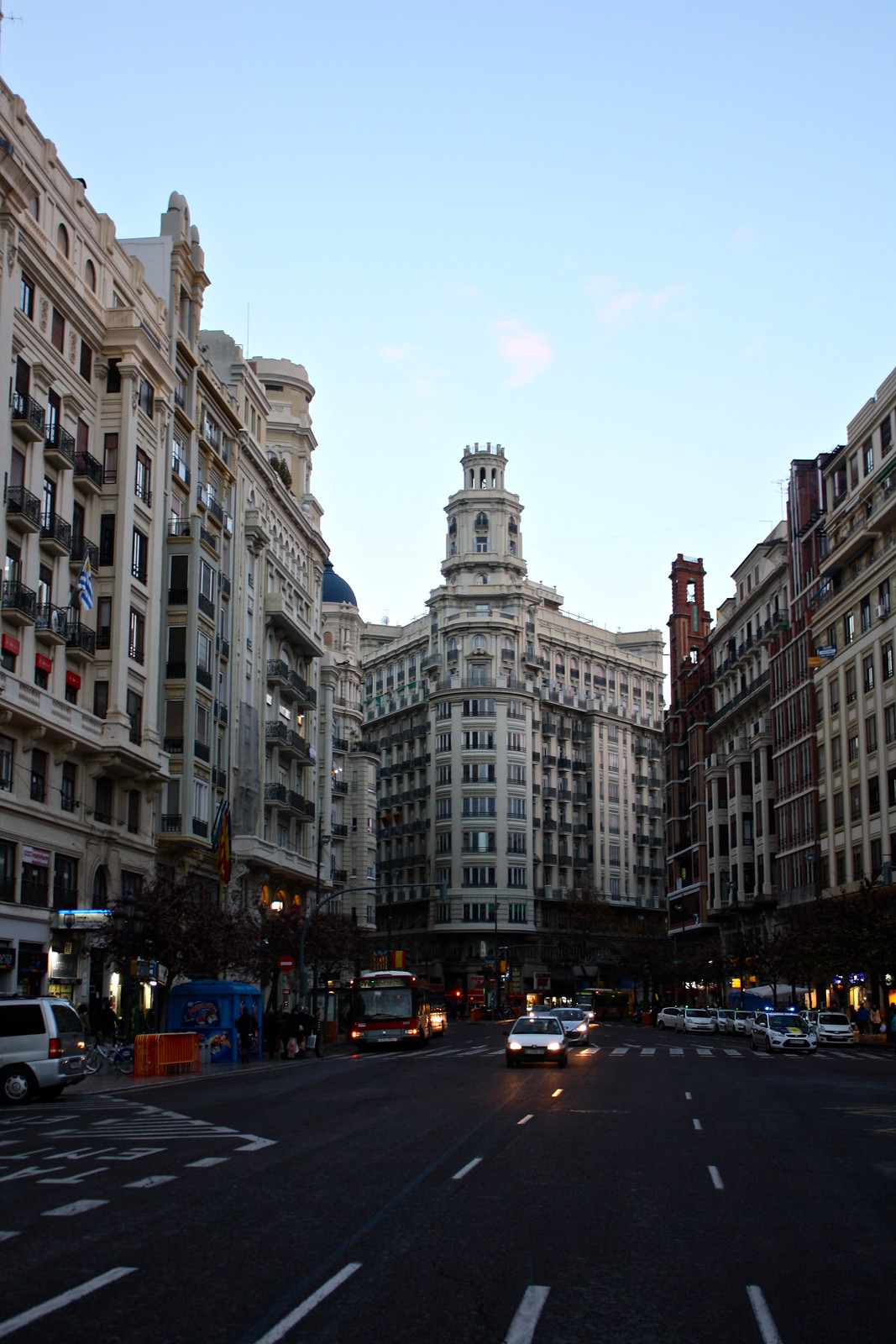 |
| Northern edge of Plaza del Ayuntamiento |
If you don’t take the high-speed AVE train to Valencia, you’ll disembark from a normal-speed train in the Estación del Norte, a lovely Modernista station from 1917 with a lobby decorated with mosaic tiles and “bon voyage” in several languages. Just a short stroll to the north is the Plaza del Ayuntamiento (“Town Hall Square”). Naturally, the turn-of-the-century ayuntamiento or town hall can be found here, with its gleaming white façade capped by square towers and metallic orange domes. If you look closely, you can see a statue of a bat, a symbol of many cities and lands belonging to the former Crown of Aragón. On the opposite side is the oficina de correos or post office, which is just as grand as the town hall and even has a mad-scientist-style communications tower and a huge stained glass ceiling in the foyer.
This plaza couldn’t be a better introduction to the city, what with its tall, white Modernista buildings, colorful Valencian flags, and palm trees.
 |
| La Lonja, the silk exchange |
At the nearby Plaza del Mercado (“Market Square”), you’ll find—to no one’s surprise—the central market (Mercado Central in Spanish, Mercat Central in
A few steps across the street is the silk exchange (La Lonja de la Seda in Spanish, Llotja in Catalan). This glorious Gothic building dates from the 1400s and represents the high point of the city’s prosperity; until the discovery of the Americas, Valencia, like Venice, was one of the key ports on East-West trading routes. Inside, grooved pillars twist like threads, and the whole exterior is decorated with squat pointy arches and stone crowns.
 |
| Lantern tower of Valencia’s cathedral |
The Plaza de la Reina (“The Queen’s Square”) is dominated by the warm cathedral. Built in the High Middle Ages after the Christian conquest of Moorish Balansiya, this Gothic church has two towers that compete for attention. First you have the lantern tower at the transept (central crossing of the naves). In typical Catalan style, it’s octagonal, and its pale stone construction coupled with large, delicate stained glass windows creates a truly heavenly mood. And next, you have the belltower—nicknamed Miguelete (Micalet in Catalan)—to the side of the church. Also octagonal, this weighty tower can be climbed up and its summit gives a great view of all Valencia. To the south is the Plaza de la Reina and to the north is the Plaza de la Virgen. Don’t get it confused, however, for the belltower of the Church of Santa Catalina. This tower looms over the two oldest horchata joints in town, or cafeterias that serve milky smoothies of tigernuts. More on that below in the “Food” section.
Oh, and the Holy Grail is kept in one of the cathedral’s chapels. Sorry, I couldn’t resist—it’s actually what is believed to be the Holy Chalice (Santo Cáliz), or cup that Jesus used at the Last Supper. The relic, after hiding out in the northern Iberian peninsula for hundreds of years, resurfaced in the late Middle Ages and came to Valencia, where it has remained since the early 1400s. The other three competing relics don’t seem very legit compared to the Valencian one, so it’s quite possible this might be the real deal—especially since there’s no wild legends attributed to it. The Holy Grail is a separate medieval tradition about a cup that supposedly caught the blood of Jesus as he died on the cross. Said cup may or may not have been the same one used at the Last Supper.
 |
| Plaza de la Virgen, seen from the Miguelete belltower |
Walk around the cathedral to the north and you’ll end up at the Plaza de la Virgin (“The Virgin’s Square”). The cathedral’s still there, though, but on this edge you can see the stunning Apostles Portal with its Star of David-shaped stained glass (Puerta de los Apóstoles) and an arcade of columns looking very Colosseum-like. The next-door Royal Basilica of Nuestra Señora de los Desamparados is a Baroque church that houses a statue of Our Lady of the Forsaken, Valencia’s patron saint who is carried out during the Fallas festival and festooned with flowers. Across the plaza is the Gothic-style building that houses the Generalitat, or regional government of the Valencian Community.
 |
| Serrano Towers |
Like most European cities, Valencia tore down its medieval walls as its population grew and internal security was assured a few centuries ago. Two gates with twin towers were left, however: the Serrano Towers just to the north of the Plaza de la Virgen and the Quart Towers on the western edge of the old town. The Serrano ones are sharp and octagonal, while those of Quart are round and grungy. If it’s not rainy, you can probably go up on top of the towers and feel like a medieval soldier.
City of Arts and Sciences
 |
| Opera house |
Called Ciudad de las Artes y las Ciencias in Spanish and Ciutat de les Arts i les Ciències in Catalan, this cultural and educational “city” occupies a large tract of land where the Turia River once flowed. A disastrous flood in 1957 mandated the rerouting of the river away from central Valencia, and the resulting river basin was turned into a pedestrian park. In 1996, work began on the complex—situated near the mouth of the old river—and was finished just under a decade later. It was designed by Spanish architects Santiago Calatrava (himself from Valencia) and Felix Candela.
Going from northwest to southeast, you encounter one stunning feat of modern architecture after another. The Palau de les Arts Reina Sofía (“Queen Sofía Arts Palace”) is Valencia’s opera house, and just as iconic as that of Sydney, Australia. Although my initial thoughts were, the mothership has landed, the “palace” also reminded me of a giant, hulking pillbug scurrying down the riverbed.
 |
| Hemisfèric, science museum, bridge, and Àgora |
On the other side of a bridge bobs the egg-shaped Hemisfèric in a shallow pool of water. This “hemispherical” structure contains a theatrical space that doubles as an IMAX cinema and planetarium, as well as a locale for laser light shows. The pupil of the eye-like space is where films are shown, and the surrounding area can be used for meetings.
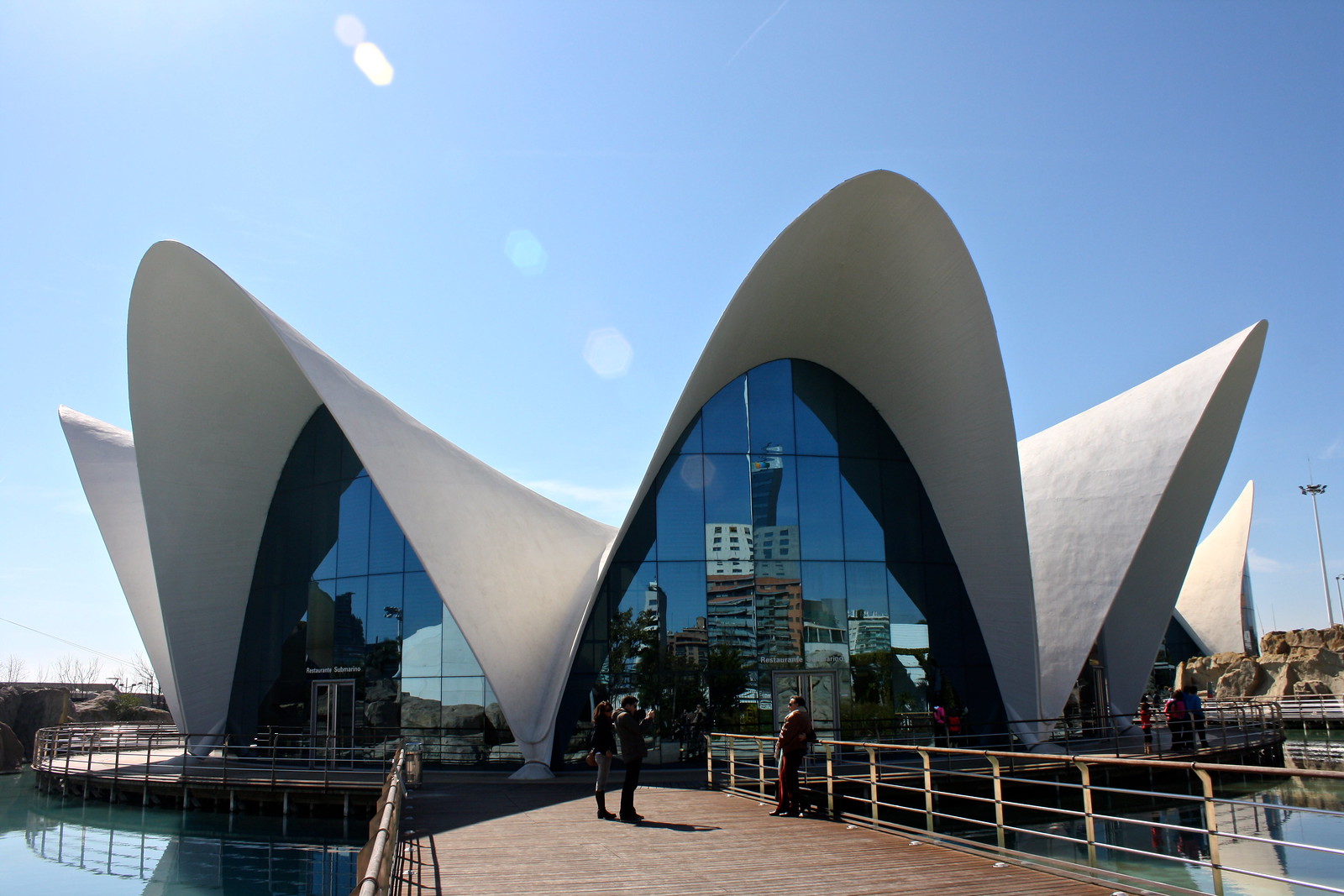 |
| Fancy restaurant at the aquarium |
Nearby, the Museu de les Ciències Príncipe Felipe (“Prince Felipe Science Museum”) is a three-story, uh, science museum with a bright white
Dividing the complex in half as it spans the riverbed, the Pont de l’Assut d’Or (“Golden Dam Bridge”) holds the title of tallest structure in Valencia. It’s been nicknamed “jamonero” because the bridge resembles the wooden tool used to hold a leg of cured ham (jamón) in place while slicing strips of meat off of it.
 |
| Obligatory fish picture from the aquarium |
The blade-like, indigo Àgora is a “covered plaza” (Wikipedia’s words) used for sporting events, concerts, and conventions. It takes its name from the ancient Greek public space that was used for trade and gatherings.
Finally, we get to the star of the City of Arts and Sciences: Oceanogràfic. The largest “oceanographic” aquarium in all of Europe, it encompasses all types of marine habitats from tropical to arctic. Not only do you get the expected fish and sharks exhibits but also ones on penguins, beluga whales, and deep-sea life. There’s a good two or three long glass-enclosed tunnels where you can walk underneath all the sharks, fish, and stingrays floating around in the tanks—a really cool experience.
 |
| Up-close-and-personal Scarlet ibis |
My favorite part of the whole aquarium wasn’t the fish, though, but a wire dome encasing the wetlands sections. Although the exhibit was built ostensibly to showcase water-based life in marshes and swamps, the tame birds inside steal the show. Fire-engine red Scarlet ibises and soft pink Roseate Spoonbills hang out among the trees and roots and let you get within inches (yes) of them, making for fun photo opportunities and a great way to learn about and appreciate nature.
Food
 |
| Hortxata & fartons at Horchatería Santa Catalina |
Okay, enough talk about the “pretty” side of the city—let’s get on to the “tasty” side! One of the things I was most looking forward to tasting was the creamy beverage called horchata (spelled hortxata in Catalan). In contrast with its Mexican equivalent of the same name, it’s not made with ground rice but rather tigernuts, which are the tubers (think potatoes, carrots, etc.) of the tigernut sedge, a grass- or rush-like plant that grows near Valencia. The resulting white liquid smoothie has a sweet, milky flavor with subtle, colorful veggie hints. You dunk into the horchata long spongy donuts called fartons. No, not a fart, silly—a fartón. I ended up trying this refreshing drink each day I spent in town, it was that good.
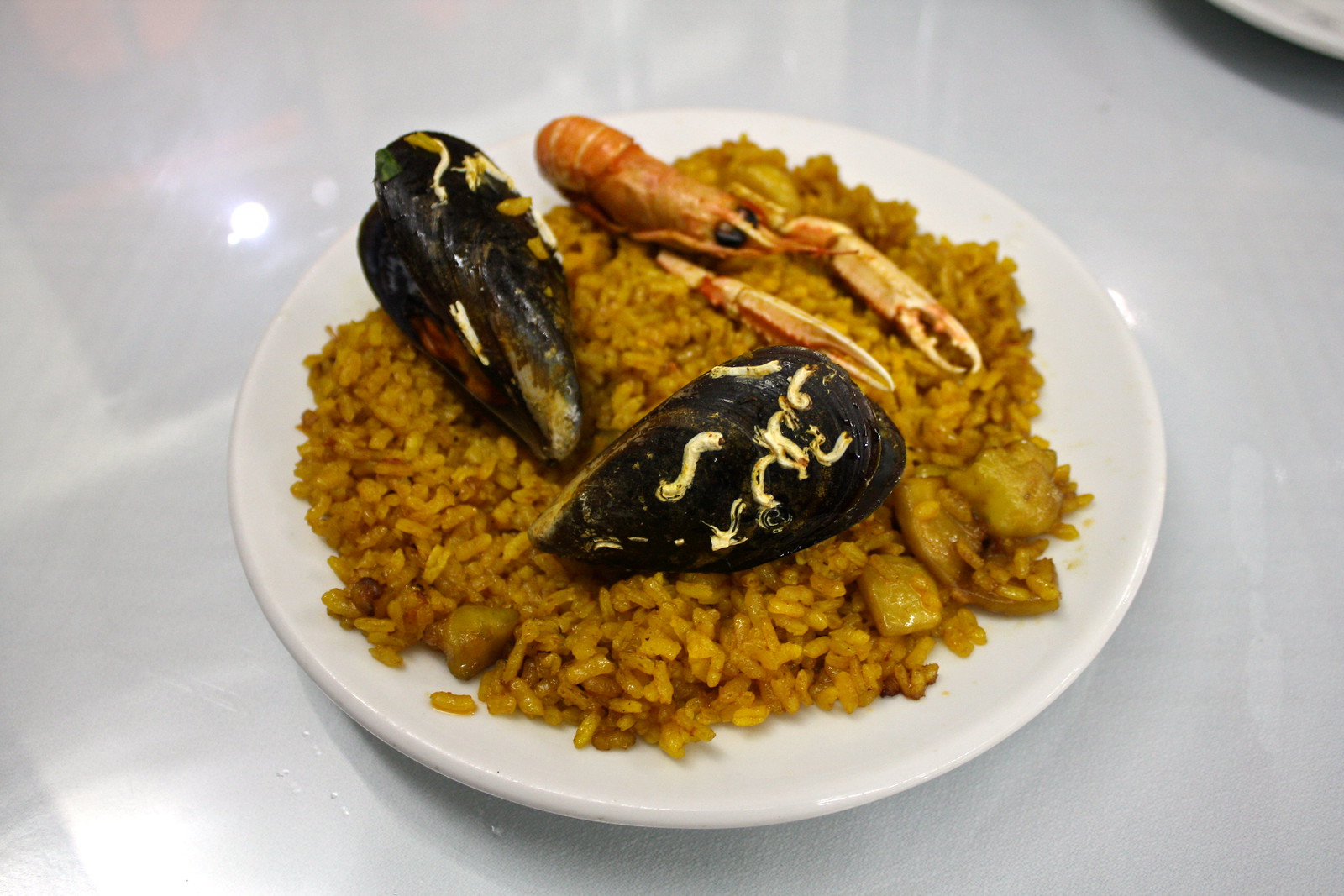 |
| Paella de mariscos (seafood paella) |
In addition to horchata, Valencia is also famous as the place where the dish paella began. Paella (pronounced “pah-AY-yah” [paˈe.ʎa]) is a rice-based dish that involves meat, veggies, and seasonings like saffron that color the round rice a beautiful golden yellow. Paella valenciana (“Valencian paella”) is the classic original, made up of chicken and/or rabbit, green vegetables (like peppers, artichokes, or asparagus), and beans. Paella de mariscos (“seafood paella”) trades the land animals, veggies, and beans for shellfish and crustaceans. Paella mixta (“mixed paella”) is a combination of any/all of the above.
 |
| Street art depicting making paella |
I tried my hardest to get the friends I toured the city with to order paella with me—you know it’s legit when the restaurant requires at least two people and an hour’s wait—to no avail. So I ended up getting a small serving of paella de mariscos at the La Utielana restaurant and chowed down on the tasty little critters and umami-dripping rice.
(Side-note: paella is NOT Spain’s national dish, but instead a point of pride for people from the region of Valencia. Tortilla de patatas (potato omelet) or jamón (cured ham) would be more appropriate contenders for a national dish.)
What big cities do you feel deserve more attention on the tourist trail? Have you been or are planning to visit Valencia? Comment below!
